| 史跡調査 遣米使節の旅 Historical Site Research - The Journey of the Japanese Delegation in 1860 ニューヨーク New York *文中の日付けは和暦で、( )内が西暦による日付 * The year in the bracket is by the Japanese calender. |
||
|---|---|---|
| 万延元年(1860)の遣米使節一行は、ワシントン〜ボルチモア〜フィラデルフィアと汽車で移動し、サウスアンボイから河船「アライダ号」に乗り換えて四月二十八日(1860年6月16日・土曜)、ニューヨーク・マンハッタンの最南端バッテリーパーク埠頭に到着した。「日本人はニューヨークが最後で、帰国する」という報道に、近在の街からもやってきた人も含め50万人の人々が、ブロードウェイを行進する遣米使節一行を歓迎した。 In 1860 (the Year of Man-en 1st), the Japanese delegation traveled from Washington to Baltimore, to Philadephia and then to New York mostly by train. When they traveled from Philadelphia to New York, they got off the train at South Amboy, New Jersey, and got on board the steamboat Alida. The boat arrived with the delagation on board at No. 1 pier near the Battery Park at the southern tip of Mahattan on Saturday, June 16, 1860 (April 28). They paraded on Broadway and other streets and, on the way, they were welcomed by about half million people including many from nearby communities partly because it had been reported that New York would be the last city the Japanese would visit before leaving for their country. |
||
| 「サムライ・イン・ニューヨーク展」 Exhibit "SAMURAI IN NEWYORK" 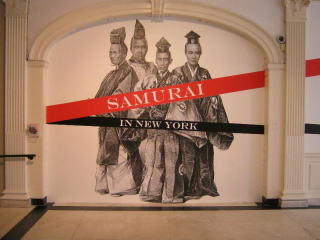 |
||
| 「サムライ・イン・ニューヨーク展」 ニューヨーク市立博物館では2010年の遣米使節150周年を記念して、「サムライ・イン・ニューヨーク展」を6月25〜11月7日まで開催しております。 関連ページ Japan-NYC 1860-2010: A Heritage of Friendship 万延元年遣米使節団のニューヨーク訪問150周年記念(リンク) SAMURAI IN NEW YORK: THE FIRST JAPANESE DELEGATION, 1860 ニューヨーク市立博物館のページ(リンク) Japan-NYC 1860-2010: A Heritage of Friendship 万延元年遣米使節団のニューヨーク訪問150周年記念(ニューヨーク日本総領事館のページ・リンク) 今年は遣米使節団150年 万延元年遣米使節団のパナマ通過 150年前、ワシントンDCに滞在した遣米使節団 万延元年遣米使節団 万延元年遣米使節・ウィキペディア ネジ釘も里帰り展示 この展示に、小栗上野介がアメリカ土産として持ち帰ったネジ釘も東善寺からアメリカへ里帰りして展示されています。 関連ページ 遣米使節の業績(東善寺→小栗上野介→) "Exhibit: Samurai in New York" - Museum of the city of New York holds an exhibit titled "Samurai in New York" from June 25 till November 11, 2010, in commemmoration of the 150th anniversary of the Japanese delegation in 1860. Related Web sites: Japan-NYC 1860-2010: A Heritage of Friendship Museum of the city of New York: SAMURAI IN NEW YORK - THE FIRST JAPANESE DELEGATION, 1860 The screw that Kozukenosuke Tadamasa Oguri brought back from the U.S. to Japan in 1860 as a souvenir is also displayed in the exhibit. It is a kind of home visit for the screw. |
||
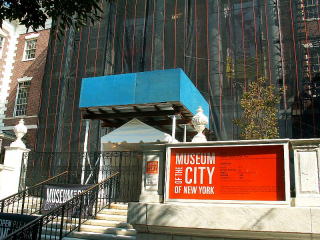 |
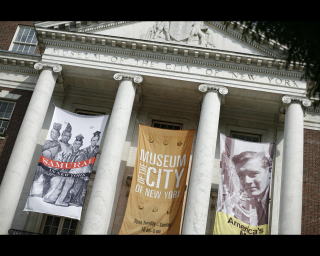 |
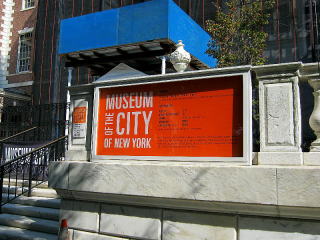 |
| ▲ ニューヨーク市立博物館は、セントラルパークの東側にあります。ちょうど外装工事中(左写真)で、本来は大きな垂れ幕で宣伝している(真ん中写真)ということです。 ▲ Museum of the city of New York is located on the east of Central Park. Unfortunately, renovation work was going on and the building could not be seen well when we visited (photo on the left). Once the work is done, big banners will be hung to advertise the exhibit (photo in the center). |
||
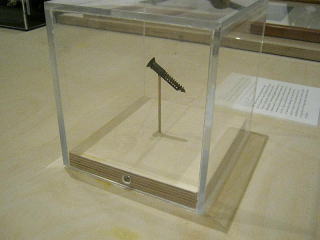 |
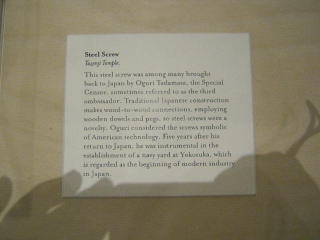 |
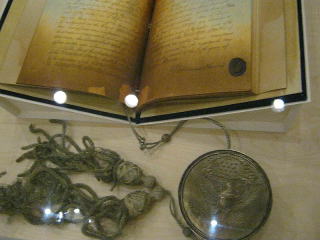 |
| 里帰りしたネジ釘▲ 解説に「小栗上野介はネジ釘をお土産として、日本をこのようなものをどんどん造れる国に変えることをめざした… 」とあります。 The scree visiting home ▲ The note describes that Kozukenosuke Tadamasa Oguri brought back the screw to Japan and hoped that he would change the country so that it would be able to manufacture things like this in large numbers someday. |
▲日米修好通商条約批准書 ▲ The instrument of ratification of the Treaty of Amity and Commerce between Japan and the United States |
|
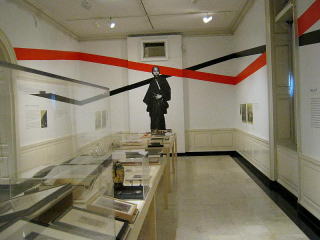 |
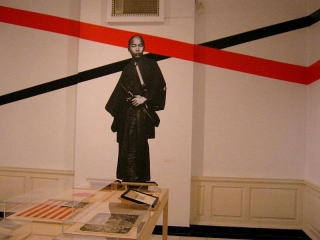 |
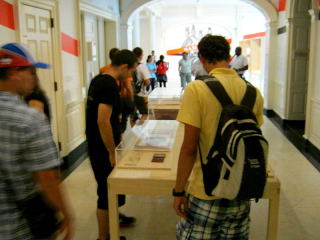 |
| ▲トミー 当時のアメリカで人気絶頂となった通訳見習いの少年、立石斧次郎の大きな画像が目立ちます。 ▲ Tommy: The figure of Onojiro Tateishi, an apprentice interpreter of 16 years old at the time, is eye-catching in the exhibit. He was the center of the attraction among American people, especailly among ladies, during the journey because of his fearless and cheerful character. |
▲観客 会場には日系人、アメリカ人を問わず、大勢の人が次々に訪れて、資料に見入っていました。 ▲ Visitors: While we were at the exhibit, they had many visitors, Americans and Japanese, who were eagerly looking into the exhibits. |
|
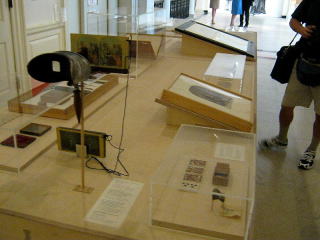 |
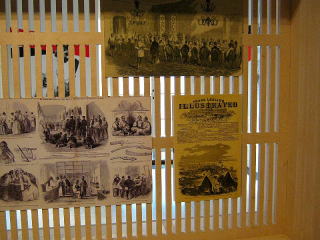 |
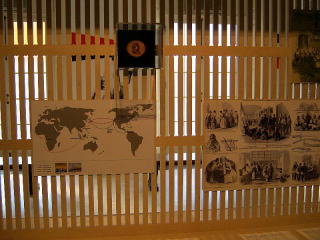 |
| ▲立体写真 当時最新の立体写真の覗き眼鏡もあります。 ▲ Stereograph: Special glasses are exhibited for visitors to see stereographs which were of leading-edge technology in mid-19th century. |
▲アメリカの新聞記事 当時のアメリカで報道された遣米使節一行の記事が、紹介されていました。 ▲ Newspaper Articles: They exhibit newspaper articles in 1860 in U.S. that reported the Japanese delegation. |
|
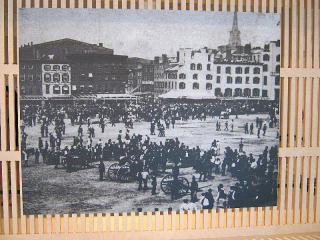 |
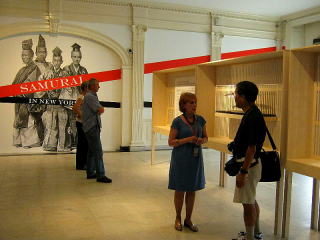 |
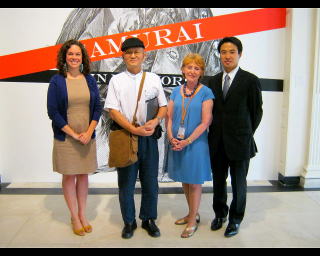 |
| ▲ニューヨークの波止場に集まった人々 歓迎の祝砲を放つ回りにたむろしています。 ▲ Crowd gathered at the wharf of New York: People are watching the gun salutes for the Japanese delegation near Battery Park at the southern tip of Manhattan. |
▲博物館と日本総領事館のスタッフ 企画展示を担当したスタッフと、総領事館広報センターのスタッフが、歓迎してくれました。 ▲ People of Museum of the City of New York and of the Consulate-General of Japan in New York: We were welcomed by people of the museum in charge of the exhibit and of the Japan Informatin Center of the Consulate-General. |
|
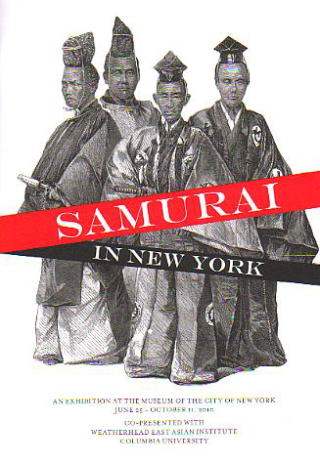 |
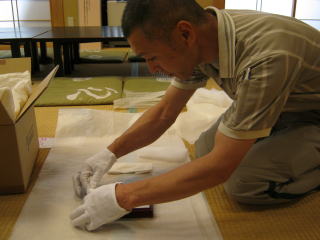 |
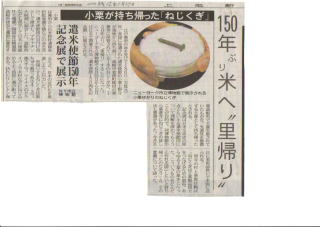 |
| ▲パンフレット 会場では立派なパンフレットが配られていました。 ▲ Brochure: Excellent brochures were distributed to the visitors in the exhibit room. |
▲ネジ釘の発送作業 美術輸送専門の業者がやってきて、ていねいに幾重にも梱包して、大金の保険をかけて運んで行きました。 ▲ Packing of the screw: A transportation company specialized in art objects sent us a person, who packed the screw severalfold and took it for the dispatch which was insured for a lot of money. |
▲上毛新聞記事 新聞も里帰りしたネジ釘を報道してくれました。 ▲ Article of Jomo Shimbun Newspaper: Jomo Shimbun reported the screw visiting home. |
| ブロードウェイを行進 Parade on Broadway |
||
| 6月16日(土)朝、一行はフィラデルフィアから汽車でサウス・アンボイまで来て、迎えの河船「アライダ号」に乗り換え、ニューヨーク・マンハッタン島の南端の波止場・バッテリーパークに上陸しました。そこから馬車の行列でブロウドウエーを北上→→グランド通りで右折し→→ボウェリー通りを北に進んで→→4番アヴェニューになり→ユニオンスクエア(公園)西側通りでさまざまな兵士の分列行進を観閲し、再びブロウドウェーを南に下がって、→→メトロポリタンホテルに到着しました。前述のように、この近在から駆け付けた人々も含め一説に50万人という空前の人々が集まって、遣米使節を歓迎しました。 The Japanese delegation traveled by train from Philadelphia to South Amboy, New Jersey. Then, they got on board the steamboat Aliada and proceeded to New York. They landed at the No. 1 pier near today's Battery Park at the southern tip of Manhattan, where they got on horse-drawn carriages to parade the streets of New York. They started the parade at the Battery, marched on Whitehall St. to the north, Broadway to the north, Grand St. to the east, Bowery St. to the north, Fourth Ave. to the north, around Union-square, and Broadway to the south, and arrived at the Metropolitan Hotel. As stated earlier, they were welcomed by about half million people including many from nearby communities. ◇バッテリーパーク(一番下の緑色地帯)の左右両岸に突き出て並ぶたくさんの波止場の数が、国際商業都市の繁栄を象徴している。 ◇ Battery Park is the green area at the bottom in the map blelow. As you can see, there are a lot of wharves poking out on both east and west sides of the south end of Manhattan Iskland. The large number of the wharves symbolizes the prosperity of the interenationally commercial metropolis. |
||
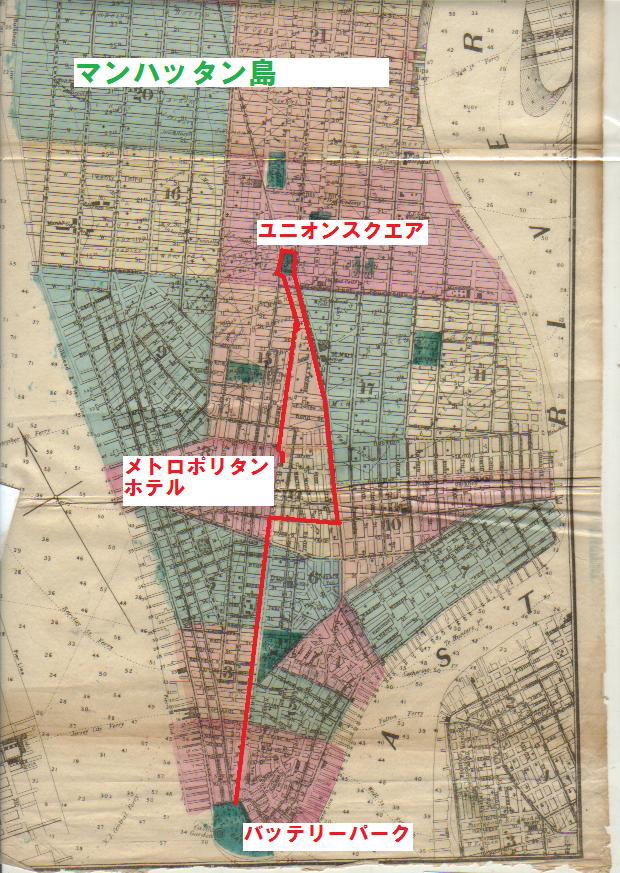 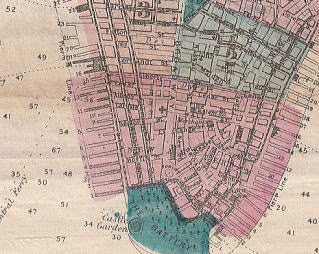 ▲バッテリーパーク拡大図 いちばん下の公園近くに上陸した。左の丸い建物がバッテリー(砲台) 古地図(1868年・宮永孝氏提供・東善寺蔵) Map of the year of 1868 (Courtesy Mr. Takashi Miyanaga - Owned by Tozenji Temple) |
||
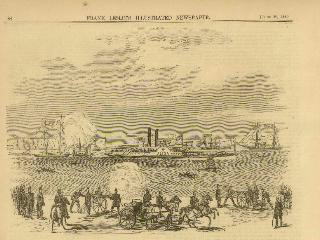 ▲アライダ号のニューヨーク到着を祝う祝砲 ▲ Gun salutes for the arrival of the Japanese delegation by the steamboat Alida. |
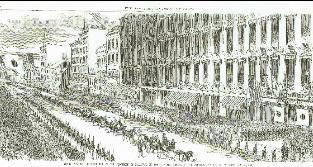 ▲メトロポリタンホテルに着いた使節一行 ▲ The Japanese delegation arriving at the Metropolitan Hotel |
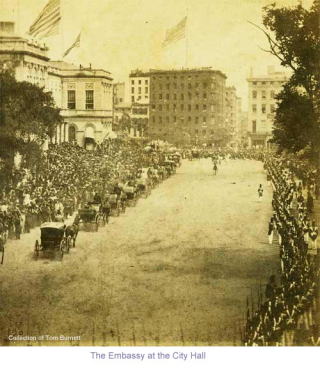 ▲ニューヨーク市庁舎前を行く ▲ They paraded the street in front of the New York city hall. |
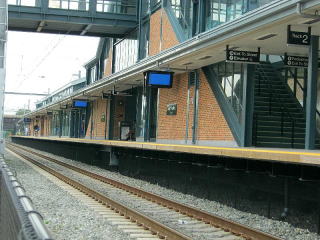 |
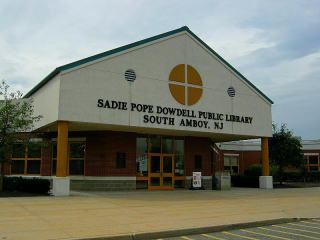 |
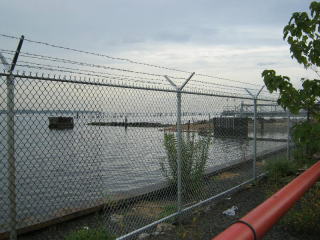 |
| ▲サウスアンボイの駅 ここはがらんとした田舎の駅の風情で、昼間の人影はなく150年前の日本人の通過など全く忘れられた歴史になっている ▲ The railway station of South Amboy: It is a small station in a quiet remote town and there was no passengers at all when we visited. It looked as if the history of the Japanese delegation who got off the train 150 years ago was merely a forgotton past among the people. |
▲サウスアンボイの町の図書館 小学校と中学校の間にある。親切に調べてくれたが、いい資料は見つからない。 ▲ Sadie Pope Dowdell Public Library: It is located between a middle school and a high school. The librarians were quite kind and helpful, but unfortunately we could not get much information we wanted. |
▲アライダ号に乗り込んだ波止場付近 ▲ The seashore of South Amboy: The Japanese delegation got on boad the steamboat Alida at a wharf in this area on June 16, 1860. |
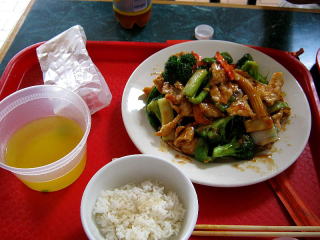 |
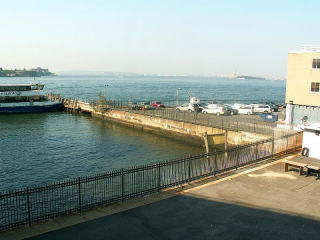 |
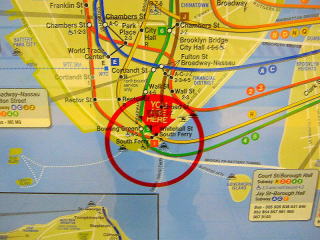 |
| ▲チキンヌードル 町の中華料理屋で量が多いのを警戒して「ヌードルスープ」だけ頼んでみたら、左のカップに数本のヌードルが泳いでいるシロモノだった。あわてて追加したのが、野菜炒め。 ▲ Chicken Noodle Soup: On a street of South Amboy, we entered a rustic Chinese restaurant. I was afraid that they would serve big dishes, so I ordered only chicken noodle soup. However, the served soup was alomost "instant soup" with a few noodles in a plastic cup. I hurriedly made an additional order for the stir-fried vegetables. |
▲波止場・マンハッタン島 アライダ号からここに上陸し、ニューヨークの大歓迎を受ける行進が始まった。使節一行が上陸した波止場は埋め立てられて、現存しない。 ▲ A wharf at the southern tip of Mahattan: The Japanese delegation landed at Pier No. 1 in this area and paraded the streets of New York receiving a huge welcome. The pier does not exist because of reclamation of the sea. |
▲バッテリー・パーク マンハッタン島の最南端の波止場付近の公園。 ▲ Battery Park: Battery park is a park at the southern tip of Manhattan island. The Japanese delegation landed at Pier No. 1 near the park. |
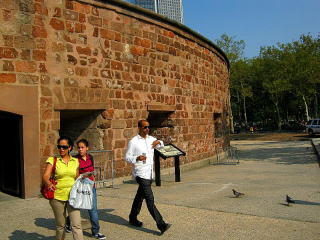 |
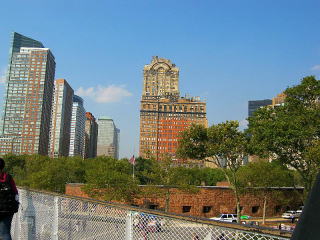 |
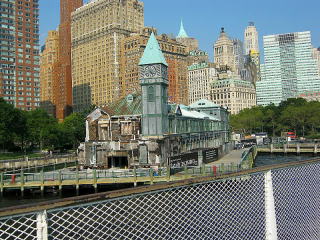 |
| ▲バッテリー(battery・砲台) 街を護る砲台があることから公園は「バッテリー・パーク」と呼ばれる。 ▲ Battery: The area is called Battery Park since there were batteies which protected the city. |
▲古い建物 バッテリーパーク周辺には古い建物もいくつか目につく。1860年当時の古地図を見ると、マンハッタン島南端部には波止場が数十本もクシの歯のように並び、そこに各国の商船がマストを乱立させて停泊し、ニューヨークは一大商業都市として繁栄していた。 ▲ Old buildings: There are some old buildings near Battery Park among modern buildings. In the map around 1860, there were dozens of piers at the souothern tip of Manhattan island where many commercial vessels berthed like teeth of a comb bristling their masts. New York was prosperous as a commercial metropolis at the time. |
|
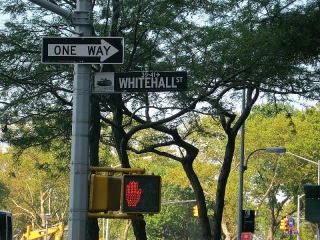 |
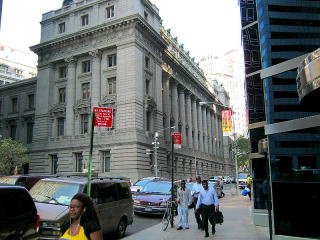 |
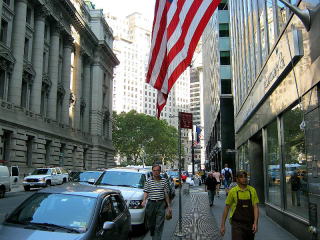 |
| ▲ホワイトホール通り 遣米使節は、左方向へ北上して、すぐにブロードウェイに入った。 ▲ Whitehall Street: The Japanese delegation paraded this street to the north (to the left) and soon proceeded to Broadway. |
▲ブロードウェイ 古い石造りの建物がたくさん並ぶ。遣米使節が行進したとき、この両側の歩道もビルの窓もいっぱいの人々が一行を歓迎し、並木に登っている人までいた。 ▲ Broadway: Many old stone buildings are still standing. When the Japanese delegation paraded, the pavements and the windows of buildings were jammed with huge crowds on both sides who were welcoming the Japanese. There were people even on trees around. |
|
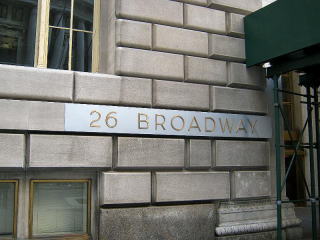 |
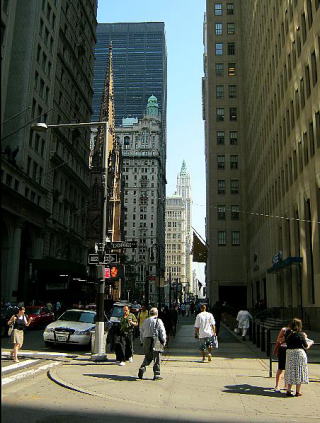 |
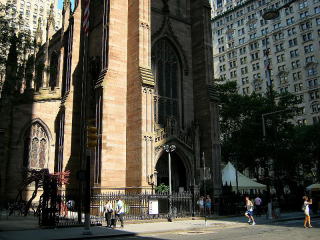 |
| 行進のコースは 使節は行進の途中、ユニオンスクエア西側の通り(ユニオンスクエア西通り)に設けられた桟敷台に座り、目の前を次々と分列行進する各種軍隊のきらびやかなパレードを観閲した。 During the parade, the Japanese delegation was stationed on a platform on the west side of Union Square and reveiwed the spectacular parades of various units of soldiers who paid the honors of a marching salute to them. |
||
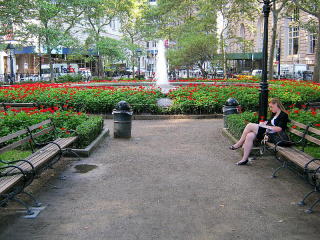 |
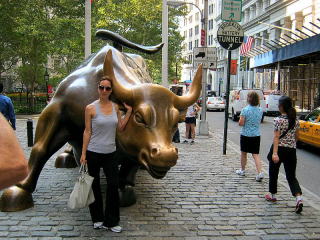 |
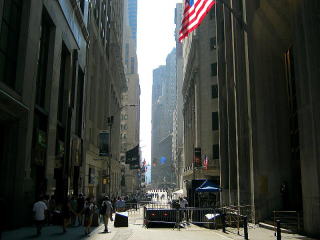 |
| ニューヨークの町並み▲ ▲ ▲ 高いビルが多いため、道路が狭く感じられ、とにかく空が狭い! The town of New York ▲ ▲ ▲ There are so many skyscrapers that we car barely see the sky and the streets looked narrower. |
||
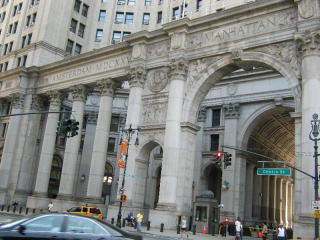 |
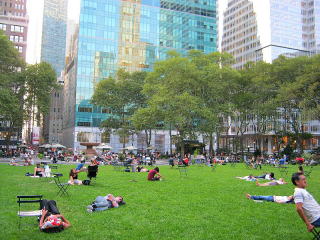 |
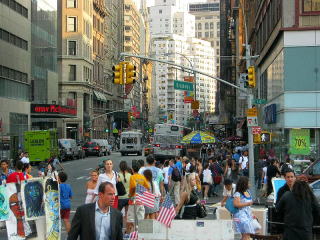 |
| 近代的なビルが立ち並ぶニューヨークというイメージだが、実際にはかなり古いビルも残されていて、ミックスして街に溶け込んでいる。 We usually imagine New York as a city with many modern buildings, but in fact there are a lot of old buildings nicely mingling with the new buildings. |
||
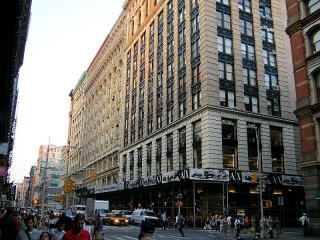 |
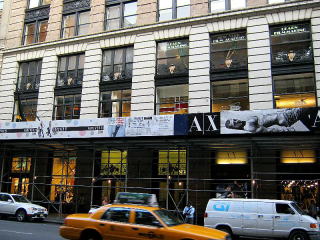 |
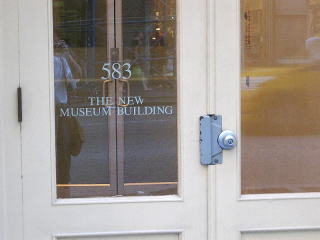 |
| ▲メトロポリタンホテル跡 今はいろいろな店が入る商業ビルになっていて、店員に「ここが150年前にはホテルで…、」と話しかけても「はあ?」と全く反応がないのは、無理もない。 ▲ The place where the Metropolitan Hotel was located: Today, there is a big commercial building with various stores at the place. We told some store clerks, "there was a big hotel here 150 years ago ...," but they did not show much interest. It was not surprising at all. |
||